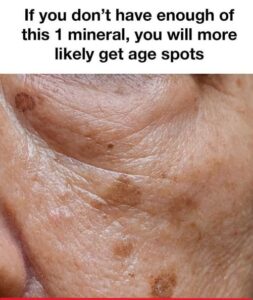What I Learned Today About Age Spots and the Power of Selenium for Skin Health

As we age, many of us begin to notice small, darkened patches popping up on our skin. These spots—commonly referred to as age spots, liver spots, or sun spots—are flat, and can range in color from brown to black. They tend to appear most frequently on areas exposed to the sun, such as the face, hands, shoulders, and arms.
While age spots are more frequently seen in people over 50, they’re not exclusive to older adults. Younger individuals who spend a lot of time in the sun without adequate skin protection can also develop them. But what exactly causes them? The key factor is a buildup of melanin—the pigment responsible for skin color. This overproduction is often the result of long-term sun exposure, getting older, and, for some, inherited tendencies. So, a mix of UV rays, aging skin, and your genetic blueprint can all play a role.
These spots are generally harmless, but knowing what causes them and how to potentially prevent them is a valuable part of overall skin wellness.
Why Minerals Matter for Your Skin’s Vitality
Skincare is often viewed through the lens of topical solutions—creams, serums, and masks. But healthy, glowing skin truly begins from within. Your body requires essential nutrients to function properly, and minerals are a big piece of that puzzle. In fact, they’re critical for keeping your skin resilient and vibrant.
Minerals contribute to the growth of new skin cells, defend against oxidative damage, and help maintain the structure and elasticity of your skin. Minerals like zinc, copper, and selenium are especially beneficial. They serve as the skin’s internal defense system, helping it bounce back from daily damage and stay strong.
The Skin-Saving Power of Selenium
Selenium is a standout among skin-friendly minerals. It’s considered a trace mineral, which means our bodies only need small amounts—but don’t let that fool you. Its impact is significant. Selenium acts as a potent antioxidant, helping to neutralize harmful molecules known as free radicals. These unstable particles contribute to aging and cellular damage, including damage to the skin.
By fending off these threats, selenium helps maintain your skin’s natural health and supports a youthful appearance. It also strengthens your immune function and supports thyroid health, both of which are essential for keeping your body—and skin—functioning optimally.
How Selenium Connects to Age Spots
Here’s where things get interesting: when your body doesn’t get enough selenium, it becomes more susceptible to oxidative stress. And oxidative stress is a major trigger for age spot formation. Without enough selenium, your skin’s defenses against sun exposure and other environmental aggressors are weakened. As a result, your skin may produce too much melanin in localized areas—leading to those darkened patches.
Ensuring adequate selenium intake can help support your skin’s defenses and reduce the risk of sun-induced pigmentation and premature aging. It’s a powerful internal tool for skin protection.
Backed by Research: Selenium and Skin Health
The connection between selenium and healthier skin isn’t just a wellness trend—it’s supported by scientific studies. Research shows that selenium helps shield the skin from UV-induced damage and may lower the risk of certain skin cancers. It’s also been found that combining selenium with other antioxidants can enhance skin elasticity and even reduce visible age spots.
Could You Be Low in Selenium? Watch for These Signs
Selenium deficiency is relatively uncommon in well-nourished populations, but it can still happen. Signs that you might be running low include:
-
Persistent fatigue
-
Weakened muscles
-
Slow wound healing
-
Frequent infections
-
More frequent sunburns
-
Increased appearance of age spots
If any of these symptoms sound familiar, it might be worth reviewing your selenium intake with a healthcare professional.
Easy Ways to Boost Your Selenium Intake
Getting enough selenium doesn’t have to be complicated. Adults typically need about 55 micrograms per day, and that’s easy to achieve through food. Some top dietary sources include:
-
Brazil nuts – One nut may give you more than your daily requirement
-
Tuna, sardines, and halibut – Excellent seafood options
-
Organ meats – Like liver, which is naturally rich in minerals
-
Eggs, sunflower seeds, and whole grains – Easy additions to your daily meals
A well-balanced diet that includes these items can help your skin stay healthy from the inside out.
Should You Consider Selenium Supplements?
If your doctor confirms a selenium deficiency, supplements can help—but they must be used carefully. Excess selenium can be toxic, leading to nausea, hair thinning, brittle nails, and even neurological issues.
Always speak with a medical professional before starting supplements. They’ll help you determine whether supplementation is necessary and guide you to a safe dosage.
Selenium Is Just One Piece of the Skin Health Puzzle
While selenium plays a vital role, it’s not the only factor in keeping your skin protected and vibrant. Other healthy habits make a big difference, especially when it comes to avoiding age spots. Here are some effective practices:
-
Use sunscreen daily, even in cloudy weather
-
Wear protective clothing, like wide-brim hats and long sleeves
-
Stay out of intense midday sun (typically 10 a.m. to 4 p.m.)
-
Stay hydrated and eat antioxidant-rich foods like berries, leafy greens, and nuts
-
Follow a consistent skincare routine to support your skin’s barrier
Final Takeaway: Support Your Skin from Within
Selenium might be a tiny mineral, but its benefits are anything but small. From boosting skin elasticity to reducing age spots and strengthening immune health, selenium is a key player in the quest for healthier skin. Making this mineral part of your daily wellness routine—through nutritious foods or supplements (when advised)—can help you glow from the inside out.
Want to keep your skin looking its best as you age? It might be time to give this powerful mineral the spotlight it deserves.